

Editor: Jaap Horst

|
By Wallace Wyss When I was a kid, growing up in Detroit, I would hear of various designers, and they became my heroes. Guys like Harley Earl and Bill Mitchell of GM. And Eugene Bordinat from Ford. But looking back over half a century I have to say that one design superstar then that has risen higher in my estimation is that of Virgil Exner, the urbane white haired styling director of Chrysler, subsequently known as “the father of the tailfin.” He wasn’t the first Chrysler executive to assign Carrozzeria Ghia to build a Chrysler “dream car” as they were called back then, but he loved the idea once he took the helm at Chrysler Styling and supervised the commissioning of at least eighteen more from the Italian metal benders, including one that didn’t make it when the ship sank bringing it to America. When he left Chrysler (almost pushed out after he failed to recognize the market had changed) he and his son, Virgil Jr., set up shop in Birmingham Michigan and took on private clients.
And there the “retro” side of him boomed. Oh, he had already previously re-introduced lots of retro touches into production Chrysler cars, such as: But now that he was free of the Corporate dictates, he could reach back into car history and pull into the present some great names, and represent what they would look like if they were made in the mid-‘60s. This car may have been one of the ones he drew up for an article for Esquire magazine on what it would be like if some great old marques were reintroduced. Among the “retromobiles” built from that one story’s inspiration were this car, a Duesenberg modern car, and another, the Mercer, were built as one offs. The 1965 Exner Bugatti Roadster was built on the chassis of a postwar Bugatti , a Type 101C though it was a prewar chassis design. Chassis number was 101506. It left the factory in 1961.
|

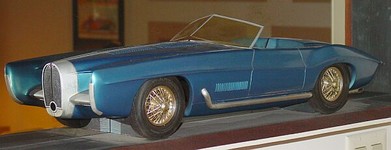
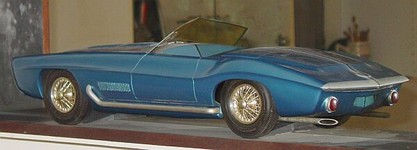
The model (only half of it, put against a mirror) which was made before the final car. Note that there are slight differences with the final coachwork
|
The November 1965, Motor Trend says: "This modern classic 2-passenger roadster is the latest thing off Virgil Exner's drawing board. It's his version of the modern Bugatti. Chassis is actually a Bugatti, shortened to 112 inches (from 130). Power comes from the last dohc Type 57 straight 8 Bugatti built in 1951 by Pierre Marko, Ettore [Bugatti's] right-hand man, who made one final attempt to revive the car. He was perhaps the longest lasting employee of Bugatti, having signed on with Ettore in 1919. He competed as a race driver at times. After the war, in August 1947, he returned to Molsheim where he became general manager. He helped the firm stay alive with non-automotive contracts, such as
general engineering work from the French Navy, Gantois, Holwegg and from SNCF for stocks of railcar spares. One automotive client was Citroën. He was behind the failed attempt to make a modern car using the then twenty year old type 57 design. Only 6 chassis/engine combinations were built and only 5 bodies fitted. Bugatti revived production of passenger cars after the war but the company was dying out, some say the decline due to the fact Bugatti's son Jean had been killed testing a car in 1939. Then, after WWII the market changed in France. It was austerity and it was hard to imagine that the glamor of the prewar art deco streamline moderne cars would ever be captured again. This particular car was able to use a lot of prewar parts that had been hidden away. The Type 101, first shown in 1951, was said to be an updated version of the Type 57. The engine was the prewar straight-eight engine, with the twin overhead cams now driven by chains instead of gears. The blown 3,257-cc Type 101C eight was rated at 200 horsepower. Modern postwar updates were a silent four-speed gearbox with overdrive and Lockheed hydraulic brakes were new, but you look up front and it was still an old fashioned solid axle. Of the five chassis of the new "Bug" that got far enough along to be bodied, two were shown at the 1951 Paris Salon. The sixth – actually never finished by the company itself since it was a show chassis -- was said to have been purchased by Exner in the early Sixties for $2,500—seems like a small amount today but back then two bedroom homes in the suburbs were under $100,000. His motive, supposedly, was to revive the Bugatti marque. The car was shown at the Turin show, but no wanna-be industrialist showed up with cash in hand to get the ball rolling.
|
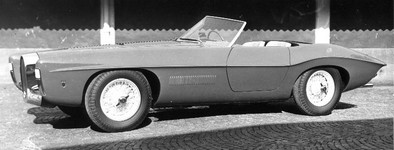
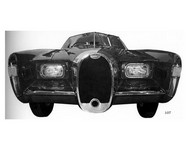
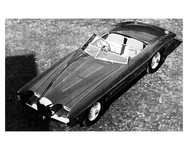
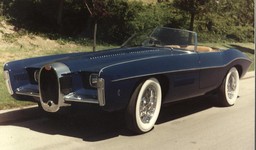
Several views of the bodywork.
|
Exner Sr. did the exterior with many of his favorite themes, such as the downward slanting rear deck, and flaring front fenders, but always respecting the most traditional element, the horseshoe shaped Bugatti-style grille (horses because the family also raised horses on the Bugatti estate). Virgil Exner Jr. designed the interior. Ghia took six months building the steel-bodied one-off. The design looks most modern from the rear (later used for his Stutz Blackhawk designs) but from the front that two piece windscreen dates it beyond redemption. The car has changed hands many times, among its owners being Southern California collector Gen. William Lyon, and a it appeared several times at the Pebble Beach concours. It was, until the latest revival of the Bugatti marque, for many of the postwar generation, the first look at a Bugatti. THE AUTHOR: Wallace Wyss is the author of 18 car histories. Wearing his artist’s hat, he is presently doing oil on canvas portraits of cars on commission, and has prints available of prewar Bugattis. For a list, contact Photojournalistpro2@gmail.com |